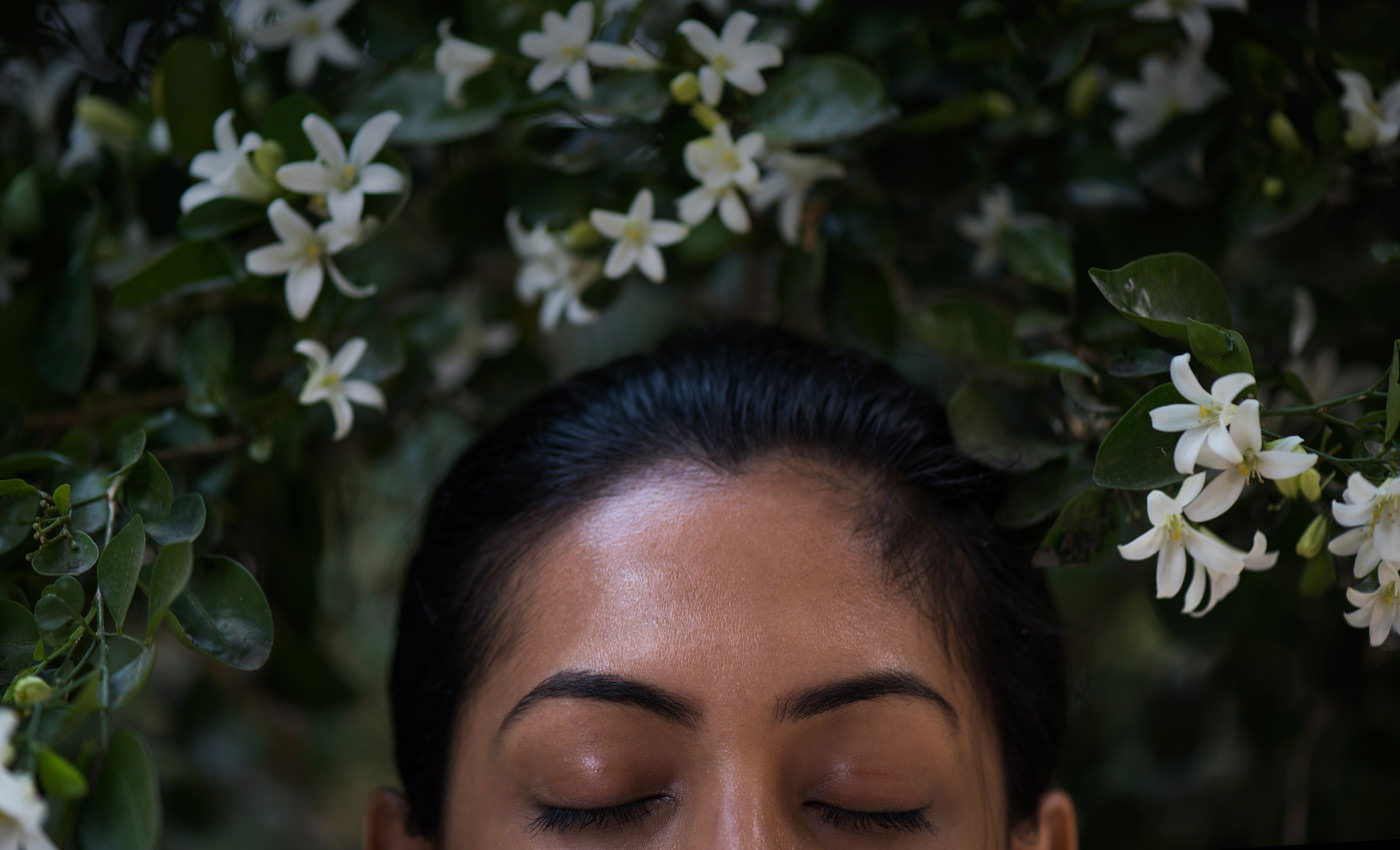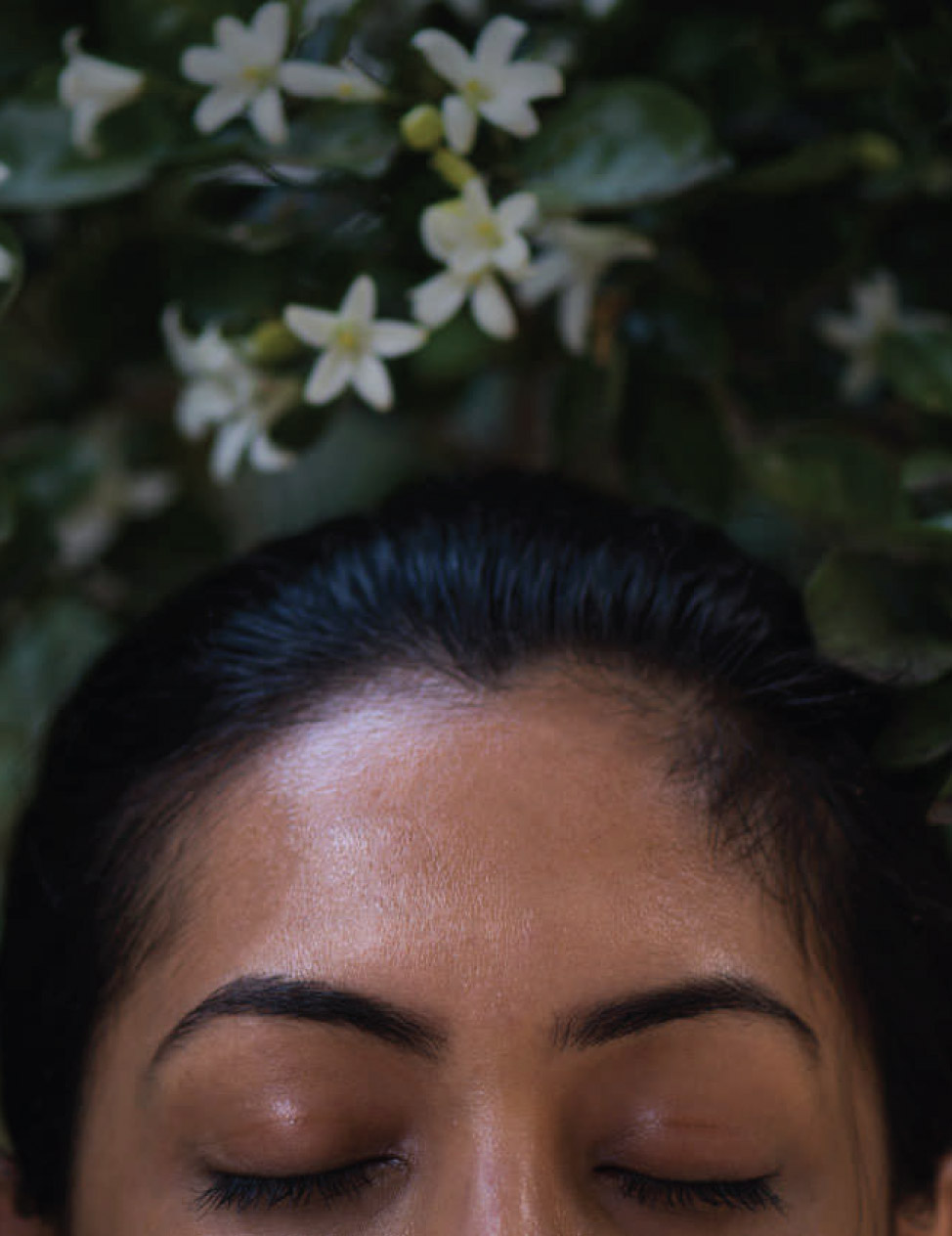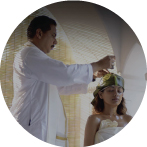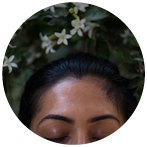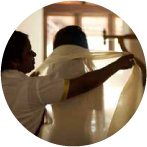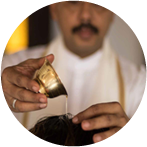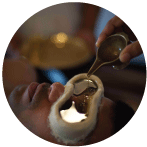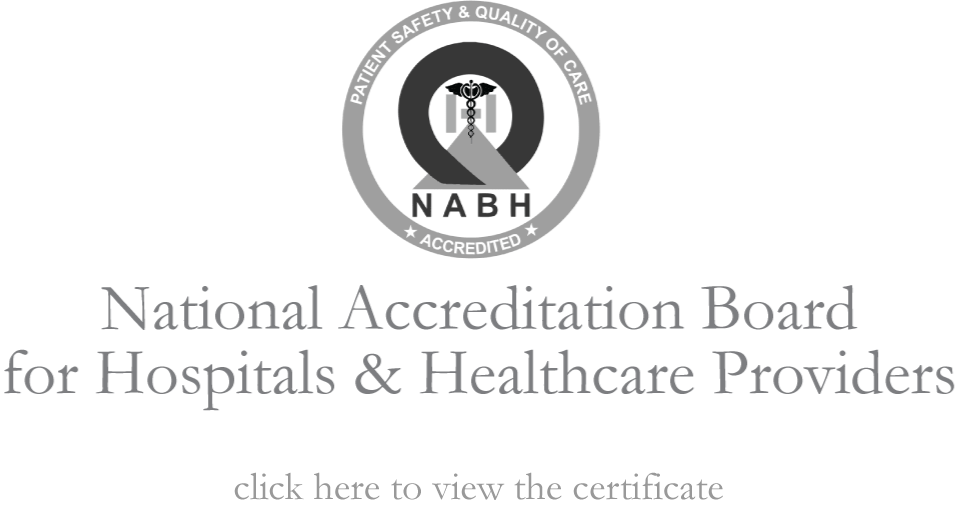Treatment Duration – 14 to 28 days
Literally meaning mental peace, treatments for stress management work to relieve the ill-effects that come from the burden of mental strain-stress,insomnia, lack of concentration ,fatigue and headaches, and help in improving your mental health. The treatment course for Manashanti chikitsa/treatment follows the 3 stages, Poorvakarma- preparatory phase, Shodana – cleansing or eliminating phase and finally Samana which is the corrective and rejuvenation phase.
During the first stage, the body is prepared for removing toxins through Snehanam- internal and external oleation, followed by Swedanam -therapeutic sweating. Once the body is prepared, the doctor will determine the cleansing or panchakrma treatment based on each individual’s body constitution and medical condition. These two stages of treatment will ensure that the imbalances in the doshas (body constitution) are stabilized. The third and final stage of treatment is Samana or Paschatkarma where the body is slowly brought out of the intense cleansing and elimination stage by giving corrective medicines and moderate therapeutic treatments, appropriate diet and yoga aasanas to correct and rejuvenate the body.
Treatment Process
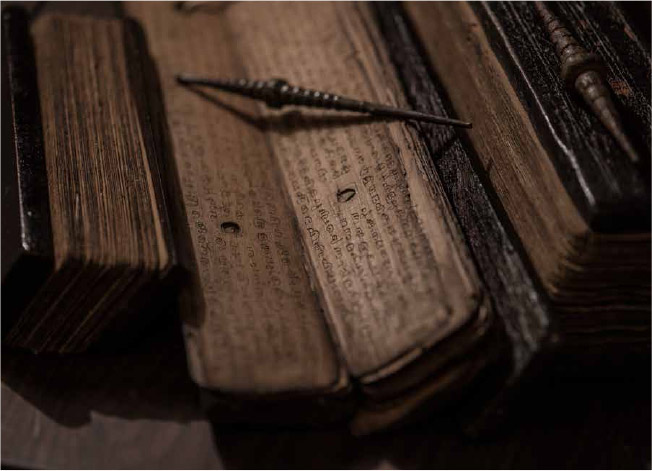
1. Diagnosis

Any treatment offered at CGH Earth Ayurveda begins with the three kinds of diagnostic procedures in keeping with the pure Ayurveda treatments. These are: 1. Darshana — Observing 2. Sparshana – Palpating and 3. Prasna – Interrogating. The Vaidya determines your Doshas or body constitution through extensive examination of your body using these methods of diagnosis and accordingly arrive at a course of treatment.
2. Treatment Course

1. Poorvakarma – preparatory stage
During the preparatory stage, the body is prepared for removal of toxins through two methods namely Snehanam where the body is oleated internally and externally and Swedanam where the body undergoes therapeutic sweating. Depending on the medical condition and Doshas, the Vaidya will determine the course of cleansing processes. In some cases there is a stage prior to Snehana called Rookshna – literally means “drying” which is done to make the body’s channels ready to absorb Sneha – oil.
Snehanam:

Internal Oleation – The body is made unctuous internally through drinking of medicated ghee (clarified butter). This helps to loosen and move the toxins towards the gastrointestinal tract. Medicated ghee consumed over 3-7 days with increasing dosage according to doctor’s prescription with restricted diet is called Achapanam. The intake of medicated ghee with the normal diet is called Vicharana.
External Oleation of the body- The body is massaged with medicated oil to make it unctuous or oily externally. This too aids in the removal of toxins. The different methods of oil application used are:
External Oleation of the body
1. Uzhichil
Therapeutic oil application on the body
2. Dadhupushtiuzhichil
Therapeutic massage done to nourish the body with medicated oil
3. Chavituuzhichil
The therapists perform deep tissue oil massage using their feet
4. Pizhichil
Oil pouring treatment
External Oleation of the head
1. Sirodhara
Medicated oil is poured
over the head
2. Sirovasthi
Medicated oils contained within a column are kept on the head over a prescribed time.
3. Siropichu
In this procedure medicated oil is retained over the head by a method using a cotton cloth soaked in oil and wrapped around the head.
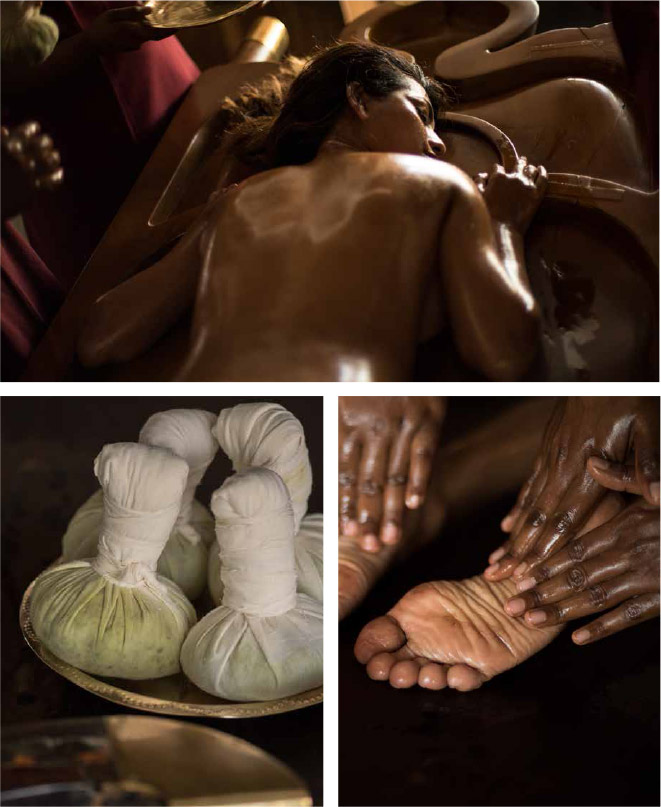
Swedanam

• Drava
1. Parishekam – Pizhichil (pouring of lukewarm oil), Dhanyamla dhara (pouring of special fermented medicated water), Kashaya dhara – Pouring of decoction on the body
2. Avagaham – Sitting in a tub with hot medicated water
• Ushama
1. Pinda Swedam
a. Podikizhi – Therapeuticmassaging with warm pouches containing herbal powders
b. Elakizhi – Therapeuti massaging with warm pouches containing different herbs and medicinal leaves
c. Narangakizhi – Therapeutic massaging with warm pouches
containing lemon, leaves and herbs
d. Dhanyamla kizhi – Therapeutic massaging using herbal pouches dipped in special herbal decoction called dhanymla
e. Njavarkizhi – Therapeutic massaging using pouches
containing medicinal rice, milk and decoction
• Kumbhi swedam
1. Steam bath
2. Nadi swedam – Local steam application through a hose etc.
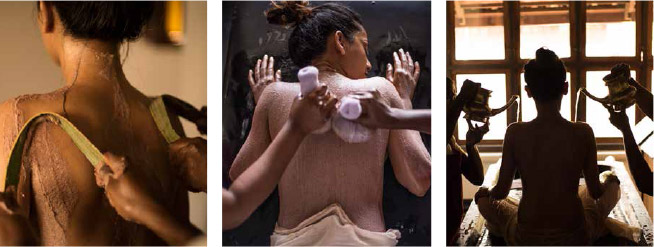
2. Shodana – Cleansing and Elimination process
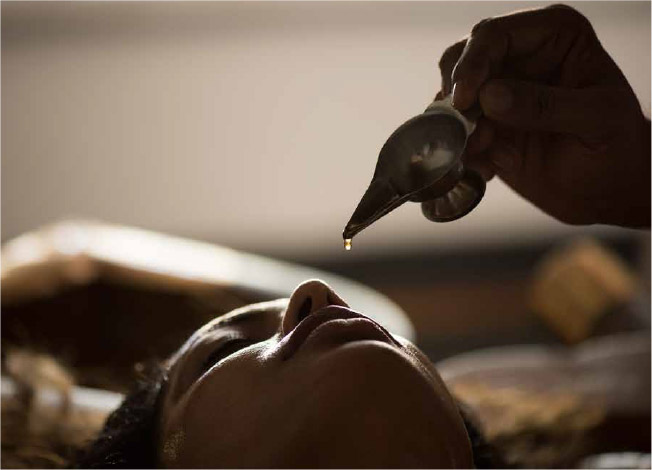
Shodanam means elimination. In Manashanthi, Shodana helps in elimination of the accumulated toxins in the body. Due to prolonged phase of stress, body responds by producing various stress hormones. These hormones may cause damaging effects on the whole body. For Shodhana we use any of the Panchakarma techniques below as per the patient’s condition.
1. Virechana – Therapeutic purging
2. Nasyam – Nasal cleansing
3. Vamana – Therapeutic vomiting
4. Kashayavasthi – Medicated enema
5. Snehavasthi – Medicated enema with oil
1. Samana or Paschatkarma- The Corrective and Rejuvenation stage
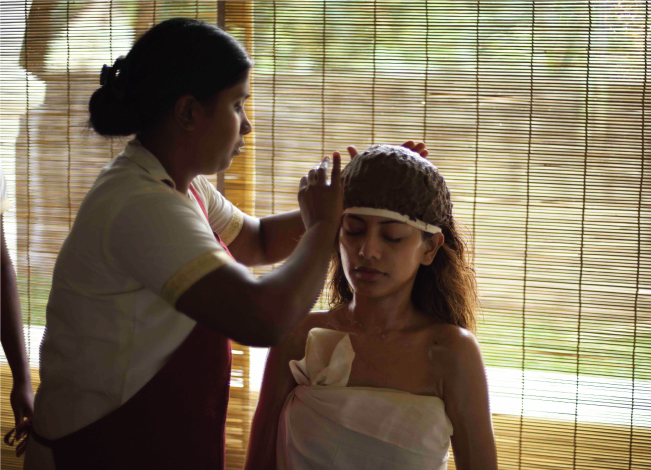
This is the third and final stage of the Manashanthi chikitsa. Moderate corrective and rejuvenating treatments are given to the patient to maintain the beneficial effects of the whole cleansing procedure. The right diet and lifestyle is also prescribed by the physician in order to maintain the benefits of the treatment. Reverting to the old ways of life and diet could worsen the condition by facilitating faster and easier accumulation of toxins. The doctor’s prescribed course of action is designed to suit each body’s unique needs and make-up and following the instructions in its entirety is mandatory to the healing process. Depending on each individual’s condition, one or more of the treatments mentioned below are prescribed:
1. Sirodhara
Pouring of medicated oil on the forehead
2. Nasyam
Here nasal medication is used
for cleansing and nourishment
3. Thalam
A herbal decoction is applied to the crown of the head which helps in relaxing the mind
4. Kashaya dhara
Rhythmic pouring of decoction or medicated milk all over the body using a traditional vessel called kindi. This helps to pacify the dosha imbalance
5. Njavarakizhi
Application of medicinal rice gruel contained in a pouch over the body. This is helpful to nourish the tissues and reduce stress in the body.
6. Njavaratheppu
Application of medicinal rice paste on the body. This treatment is more penetrating and is given for those who cannot take Najavarakizhi
7. Thalapothichal
Application of medicated paste on the head.This treatment helps to calm the mind and is helpful in getting good sleep. With the right
herbs, it is good for the hair also.
Please note; for light coloured hair, there can be a slight discoloration
due to this treatment, which is temporary. Please inform the doctor if
you use artificial colour.
8. Thakradhara
Pouring of medicated buttermilk over the forehead in a continuous stream. This also helps in calming the mind. By using appropriate herbs this treatment is also used to cure skin problems caused by stress
—Doctor’s note—
The treatment procedures are determined according to each person’s medical condition and doshas. All of the above mentioned treatments are not given to a person at one time. Additional treatments for other ailments are given to the patient as per the doctor’s diagnosis.
3. Medicines

The therapeutic treatments are supported by special internal herbal medicines. Following the traditional Ayurvedic principles, medicines, both for external and internal use, are prepared at the CGH Earth Ayurveda’s healthcare facilities from organically grown local herbs at the herbal garden. These are freshly picked for use by the gardeners who care for them with love and attention. This enhances their effectiveness. The medicines are prepared at the Ayurveda kitchen based on hygienic and traditional practices. In fact, a well thought-out scientific principle is applied to the use of all these medicines which are prepared using intensive and lengthy procedures using select ingredients and with a lot of spiritual dedication. Their consumption as per the physician’s instructions is very important and mandatory to the healing process. Specific medicines are also sourced from other reputed Ayurveda Pharmacies in Kerala.
Internal medicines
used in Ayurvedic treatments
typically include:
Kashayam – A herbal decoction
Choornam – A powdered medicine
Gulika – Tablets
Lehyam – Herbal Paste
Gritham – Medicated ghee
Arishtam / Asavam – Fermented decoction
External medicine —
Oils or Thailas:
Oils used as part of Panchakarma and other procedures are prepared with herbal decoction or fresh herbal juice. They are mixed with a medicinal herbal paste and sesame oil as the base and cooked together. This process is a long procedure taking up to 2-5 days to prepare ensuring the whole mix reaches a non-sticky stage after continuous stirring. The therapist massages this oil onto the skin making sure it is completely absorbed. This oil nourishes and regenerates the cells, stimulates the lymphatic system, releases the toxins and carries them to the surface of the skin. After treatment, the skin is washed with a paste made of chicken pea and lentil flour.

4. Food

Diet and lifestyle being core aspects of the Ayurvedic healing process, are integral to the treatment. There are many specific guidelines to be followed while consuming food as Ayurveda distinguishes six different tastes or Rasas which interact with the five elements in the body. Food is an intrinsic factor in balancing the bio-energies according to each individual’s body constitution and the balance of five elements. Ayurveda also strongly recommends the consumption of fresh and organic food and encourages mindful or meditative eating by which the full essence of food can be assimilated by the body in an aware, fully engaged and respectful manner. As part of the Manashanthi treatment at CGH Earth Ayurveda, these basic principles are strictly followed with the doctor prescribing a Sattvic diet for each person, which has a corrective and revitalizing effect. The chef at the kitchen on his part closely follows the doctor’s instructions for each individual’s diet and accordingly prepares his meals using freshly plucked vegetable organically grown at the herb garden, which in turn is tended to with care by a staff tuned to the healing ethos.
5. Yoga & Meditation
Yoga

Yoga is an ancient Indian physical, mental and spiritual practice with the origins dating back to the 5th or 6th century BC. It means to ‘integrate’ ‘combine’ or ‘unite’ and it addresses ways of integrating the body, senses, life force, the mind and the consciousness. Yoga is thus used to complement the Manashanthi treatment at CGH Earth Ayurveda with slow and steady aasanas that give absolute control of the mind and help to sharpen it. This kind of yoga is accessible to all and is light so as to support the treatment process. There is no age limit and no previous knowledge or experience required. Each one is initially supported on an individual basis until he or she is ready to partake in the group exercises. This complete body and mind experience is aimed at improving your health and total well-being.
Meditation
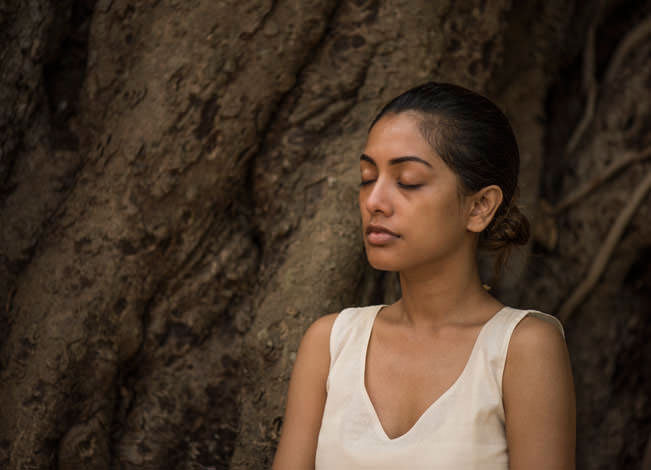
With Ayurveda’s thrust on internal healing, meditation as a practice in disciplining the mind and the thinking process is made a core part of the treatment at CGH Earth Ayurveda. Meditation techniques are used to calm and relax both the mind and the body since both the mind and the body are closely tuned to each other. One of the effective techniques of meditation used here is the Candlelight Meditation in which a group sits around a burning candle and gazes at the flame for several minutes focusing on it as long as possible and praying together. The focus here is on controlling the mind. Initially, the patient may find it difficult to concentrate and may even get a little disturbed. But with a few days of practice, he or she will be able to focus better. This meditation and breathing exercise – Pranayama — has a calming and rejuvenating effect.
6. Satsang

Satsang which can be translated as ‘true company’ (sat- true, sang- company) has always been one of the fundamental elements of Indian philosophy and it means: 1.Company of the highest truth, 2. The company of a Guru 3. An assembly of people which listens to, talks about and assimilates the truth. This involves listening to or reading the scriptures, reflecting on them, absorbing their meaning, understanding and discussing the meaning of certain words and integrating their significance into one’s daily life. The idea of Satsang may be traced back to Rishis or ancient Indian spiritual masters such as Vedavyasa and Valmiki who explained their value in numerous ways. Satsangs are thus a significant aspect of the CGH Earth Ayurvedic treatments as they add the necessary uplifting edge to the whole recovery process by enhancing positive energy. Patients are therefore encouraged to partake of a rich cultural and spiritual offering including discourses, classical music and dance performances, Mantra chanting, candlelight meditation, Yoga discourses, Kalaripayattu demonstrations and doctors’ talks during the treatment course.
Testimonials
“The changes that happened to me here are life-changing and mind-shaking. I hope to save the feelings and knowledge as long as I can and implement as much as I can. I want to thank you all, especially the therapists! It’s an amazing experience.”
– Mr Alexy Gridim
“This is my third visit to Kalari and the first to Rasayana. Each time I come here, my experience is richer and the healing deeper.This is truly a unique place and I hope that it will always be here as my place to escape to when the world and life become too much to bear. I felt loved and cradled by every single member of the team here, as if you were all my mothers! I realized the value of making others feel special in in my life in an unconditional way. Thank you to each and everyone of you. I love you all and will see you next year.”
– Ms Wilma Basta

